Duel (TCG GB): Difference between revisions
(→Comparison with the real-life game: +1 point) |
m (Text replacement - "{{TCG|Special Conditions|Special Condition}}" to "{{TCG|Special Condition}}") |
||
| (32 intermediate revisions by 5 users not shown) | |||
| Line 1: | Line 1: | ||
A '''duel''' (Japanese: '''{{tt|対戦|たいせん}}''' ''competition'') is played with Pokémon cards in the [[Game Boy Color]] video games {{ | A '''duel''' (Japanese: '''{{tt|対戦|たいせん}}''' ''competition'') is played with Pokémon [[card (GB)|cards]] in the [[Game Boy Color]] video games {{vg|Pokémon Trading Card Game}} and [[Pokémon Trading Card Game 2: The Invasion of Team GR!]]. | ||
The duels in these video games are based on [[Pokémon Trading Card Game|the real-life card game]] from when the video games were released, in 1998 and 2001, respectively. These video games are different from the modern real-life game to some extent, since they don't feature cards, rules or practices introduced later. | The duels in these video games are based on [[Pokémon Trading Card Game|the real-life card game]] from when the video games were released, in 1998 and 2001, respectively. These video games are different from the modern real-life game to some extent, since they don't feature cards, rules or practices introduced later. | ||
==Terminology== | ==Terminology== | ||
The word "duel" is often used in the first | The word "'''duel'''" is often used in {{vg|Pokémon Trading Card Game}} and its instruction booklet. | ||
===Capitalization=== | |||
In the instruction booklet of this game, this word is consistently written in lowercase. For instance: | |||
* ''"Before any turns are taken, you must choose your Active Pokémon — the one that will '''duel''' first!"'' (page 8) | |||
* ''"The following are commands you can use during '''duels''' and their uses: [...]"'' (page 15) | |||
In the internal data from the American version of this game, this word is inconsistently stored as either "'''Duel'''" or "'''duel'''". However, the dialogue is entirely displayed in all-caps (such as ''"WOULD YOU LIKE TO '''DUEL''' MITCH?"''), therefore | |||
those capitalization differences are not seen in normal gameplay. In the European versions of this game (which include multiple languages per cartridge, including English), the dialogue is not only displayed but also stored in all-caps. | |||
Some examples of inconsistent capitalization from the internal data of the American version: | |||
* ''"For our practice '''duel''', choose {{p|Goldeen}}."'' ([[Dr. Mason]]) | |||
* ''"Come again. I'll be glad to '''Duel''' you any time."'' ({{TCG GB|Aaron}}) | |||
* ''"I assume you would like to '''Duel'''? I only '''Duel''' at the Club."'' ({{TCG GB|Nikki}}) | |||
* ''"My '''duel''' with you was... quite fun!"'' (Nikki) | |||
* ''"Would you like to '''Duel''' {{TCG GB|Mitch}}?"'' | |||
* ''"Would you like to '''Duel''' {{TCG GB|Kristin}}?"'' | |||
* ''"Would you like to '''duel''' {{TCG GB|Matthew}}?"'' | |||
* ''"Would you like to '''duel''' {{TCG GB|Sara}}?"'' | |||
===Duel vs. battle=== | |||
The word "'''battle'''" is occasionally used in-game. This includes the name of the Battle Center, which is the place in a [[Club]] where players can duel each other. | |||
Here is another example: | |||
* ''"Draw 7 cards, and get ready for the '''battle'''!"'' ([[Dr. Mason]]) | |||
Additionally, some predefined {{TCG GB|deck|decks}} also use this word, such as the {{TCG|Heated Battle Deck}} and the {{TCG|Love to Battle Deck}}. | |||
For comparison, the modern real-life TCG usually uses the word "battle" instead of "duel", as seen in the game rulebook. In the [[Pokémon Presents]] from August 8, 2023, the word "battle" was mentioned, specifically referring to duels in this video game. | |||
==Dueling== | ==Dueling== | ||
| Line 11: | Line 41: | ||
When the player talks to an available [[non-player character]] duelist, the game asks if the player wants to duel. The default selected option is "No". | When the player talks to an available [[non-player character]] duelist, the game asks if the player wants to duel. The default selected option is "No". | ||
There is also a mandatory practice duel against | There is also a mandatory practice duel against {{TCG GB|Sam}} in the first game, where all actions of the player are scripted. (in the second game, the practice duel is optional) Additionally, {{TCG GB|Ronald}} appears at some points in both games and challenges the player to a duel that starts automatically, without any input from the player. Once Ronald appears and talks to the player, the player does not have the chance to perform common tasks like editing the deck or saving the game before dueling Ronald. | ||
====Against another player==== | ====Against another player==== | ||
| Line 17: | Line 47: | ||
===First steps=== | ===First steps=== | ||
When the duel starts, a screen with the opponent's face sprite and a short introductory text appears. The text contains the opponent's duelist class, name and deck name. For instance, if the player duels against | When the duel starts, a screen with the opponent's face sprite and a short introductory text appears. The text contains the opponent's duelist class, name and deck name. For instance, if the player duels against {{TCG GB|Nikki}}, the introductory text is "[[Grass Club|Grass]] [[Club Master]] Nikki", "{{TCG|Flower Power Deck}}". At the start of the game, the decks of both players are shuffled and each player draws 7 cards from their deck, which are placed into one's own hand. The deck is shuffled automatically by the game, but the game text indicates that each player is shuffling the other player's deck. | ||
Both players are required to have at least one Basic Pokémon card in their hand to start the game. If either player does not have a Basic Pokémon card, that player shows their hand to their opponent, then returns all cards from the hand into the deck, which is shuffled again and that player draws 7 cards again. | Both players are required to have at least one Basic Pokémon card in their hand to start the game. If either player does not have a Basic Pokémon card, that player shows their hand to their opponent, then returns all cards from the hand into the deck, which is shuffled again and that player draws 7 cards again. If both players do not have a Basic Pokémon card, then the players take turns to show their hand to their opponent before each returns their cards to their deck. If both players need to shuffle, then the text indicates that the other player does the shuffling; else if only one player needs to shuffle, then the game text indicates that the player is shuffling their own deck. This action is repeated as often as needed, until both players have a Basic Pokémon card in their hand. | ||
The player is required to place a Basic Pokémon in the Arena; the Pokémon chosen is the Active Pokémon (the Pokémon that is the main lead, the one that is currently battling the opponent's Pokémon). Other Basic Pokémon may be placed in the Bench. There is space for 5 Pokémon in the Bench, plus 1 in the Arena, for a total of 6 Pokémon. The player must press B to close the hand screen when they are done placing Pokémon in the Arena and the Bench. After that, the Prize cards are placed in the play area. A coin is tossed: if heads, the player plays first; if tails, the opponent plays first. | The player is required to place a Basic Pokémon in the Arena; the Pokémon chosen is the Active Pokémon (the Pokémon that is the main lead, the one that is currently battling the opponent's Pokémon). Other Basic Pokémon may be placed in the Bench. There is space for 5 Pokémon in the Bench, plus 1 in the Arena, for a total of 6 Pokémon. The player must press B to close the hand screen when they are done placing Pokémon in the Arena and the Bench. After that, the Prize cards are placed in the play area. A coin is tossed: if heads, the player plays first; if tails, the opponent plays first. | ||
| Line 34: | Line 64: | ||
===Awards=== | ===Awards=== | ||
In both games, the player usually receives one or more {{TCG|booster pack|booster packs}} when they win any duel. In Pokémon Trading Card Game, winning against the rival | In both games, the player usually receives one or more {{TCG|booster pack|booster packs}} when they win any duel. In Pokémon Trading Card Game, winning against the rival {{TCG GB|Ronald}} awards a {{OBP|Promotional Card|TCG GB1}} instead. In Pokémon Trading Card Game 2, the player is sometimes required to duel with some characters that don't award any prizes, but this allows the player to duel against other characters. Other times, the player receives a {{TCG|coin}} as the prize for winning a duel. | ||
==Duel screens== | ==Duel screens== | ||
===Main duel screen=== | ===Main duel screen=== | ||
[[File:TCG GB duel.png|thumb|Main duel screen]] | [[File:TCG GB duel.png|thumb|Main duel screen]] | ||
The main duel screen is similar to the {{pkmn|battle}} screen from the [[core series]] games. This screen displays the two Pokémon currently dueling, specifically one Active Pokémon from each duelist. The Pokémon's image, species, {{TCG|type}}, level, {{TCG|Energy card|Energy cards}} attached and [[HP]] are visible in this screen. If needed, there is a symbol indicating when either Pokémon is affected by a {{TCG | The main duel screen is similar to the {{pkmn|battle}} screen from the [[core series]] games. This screen displays the two Pokémon currently dueling, specifically one Active Pokémon from each duelist. The Pokémon's image, species, {{TCG|type}}, level, {{TCG|Energy card|Energy cards}} attached and [[HP]] are visible in this screen. If needed, there is a symbol indicating when either Pokémon is affected by a {{TCG|Special Condition}} (such as paralysis, confusion, etc.) There is also a symbol with the number of Pokémon in the Bench and another symbol with the number of Prize cards available. There are six options in this screen: "Hand", "Check", "Retreat", "Attack", "Pkmn Power", and "Done". | ||
====Shortcuts==== | ====Shortcuts==== | ||
| Line 47: | Line 77: | ||
! Shortcut!! Notes | ! Shortcut!! Notes | ||
|- style="background:#fff" | |- style="background:#fff" | ||
| B + up || View the player's | | B + up || View the player's party | ||
|- style="background:#fff" | |- style="background:#fff" | ||
| B + down || View the opponent's | | B + down || View the opponent's party | ||
|- style="background:#fff" | |- style="background:#fff" | ||
| B + left || View the player's discard pile | | B + left || View the player's discard pile | ||
| Line 59: | Line 89: | ||
| Select || Press one or more times to switch screens, in this order: | | Select || Press one or more times to switch screens, in this order: | ||
* the whole play area | * the whole play area | ||
* the player's | * the player's party | ||
* the opponent's | * the opponent's party | ||
* back to the main duel screen | * back to the main duel screen | ||
|} | |} | ||
| Line 66: | Line 96: | ||
===Hand=== | ===Hand=== | ||
[[File:TCG GB hand.png|thumb|Hand]] | [[File:TCG GB hand.png|thumb|Hand]] | ||
The Hand (Japanese: てふだ ''Hand'') screen displays a list of cards in the player's hand. This screen is able to display 5 cards at most, but the player can scroll to see the next cards. The text "<player | The Hand (Japanese: てふだ ''Hand'') screen displays a list of cards in the player's hand. This screen is able to display 5 cards at most, but the player can scroll to see the next cards. The text "<player>'s hand" is seen at the top. There are numbers in the format "x/y", where "x" is the current card pointed by the cursor and "y" is the total number of cards in the hand. (for instance, "3/9" means that the player is currently pointing at the 3rd card and there are 9 cards in the hand) The name and level of each Pokémon is visible in the list. If the player points the cursor at any card, the card's image appears at the bottom of the screen. New cards are placed on the top of the hand. | ||
All cards in the hand have two options: Play (Japanese: だす ''Take out'') and Check (Japanese: しらべる ''Examine''). If the player attempts to play a card can't be played for any reason, an error message appears. | All cards in the hand have two options: Play (Japanese: だす ''Take out'') and Check (Japanese: しらべる ''Examine''). If the player attempts to play a card can't be played for any reason, an error message appears. | ||
| Line 86: | Line 116: | ||
It's possible to see the face-down Prize cards that are available to be taken, but both players are unable to know which Prize cards exactly are available. When a Prize card has been taken, a green dashed outline remains that indicates an empty place which used to contain a Prize card. | It's possible to see the face-down Prize cards that are available to be taken, but both players are unable to know which Prize cards exactly are available. When a Prize card has been taken, a green dashed outline remains that indicates an empty place which used to contain a Prize card. | ||
The "In play area" screen displays the player's play area at the bottom and the opponent's play area at the top. This screen has a single triangle cursor that may point at any of the available places. If the player moves the cursor either to the bottom or the top of this screen, | The "In play area" screen displays the player's play area at the bottom and the opponent's play area at the top. This screen has a single triangle cursor that may point at any of the available places. If the player moves the cursor either to the bottom or the top of this screen, the player's or the opponent's party appears, respectively. The "Your play area" and "Opp. play area" have multiple options, with various black arrows pointing in the direction of the places affected by each option. | ||
The "Your play area" screen" has three options: Your Pokémon (Japanese: じぶんのポケモン ''Own Pokémon''), Your Hand (Japanese: じぶんのてふだ ''Own Hand''), and Your Discard Pile (Japanese: じぶんのトラッシュ ''Own Trash''). The "Opp. play area" screen" has two options: Opponent's Pokémon (Japanese: あいてのポケモン ''Opponent's Pokémon'') and Opponent's Discard Pile (あいてのトラッシュ ''Opponent's Trash''). | The "Your play area" screen" has three options: Your Pokémon (Japanese: じぶんのポケモン ''Own Pokémon''), Your Hand (Japanese: じぶんのてふだ ''Own Hand''), and Your Discard Pile (Japanese: じぶんのトラッシュ ''Own Trash''). The "Opp. play area" screen" has two options: Opponent's Pokémon (Japanese: あいてのポケモン ''Opponent's Pokémon'') and Opponent's Discard Pile (あいてのトラッシュ ''Opponent's Trash''). | ||
==== | ====Party==== | ||
[[File:TCG GB Pokémon list.png|thumb| | [[File:TCG GB Pokémon list.png|thumb|Party]] | ||
The | The [[party]] is similar to the [[core series]]. This screen displays the Pokémon cards currently in use by a given player. Each player has one Active Pokémon and at most 5 Bench Pokémon. | ||
One's own party is accessible from these places: | |||
* In the "In play area" screen, move the cursor to the bottom of the screen. | * In the "In play area" screen, move the cursor to the bottom of the screen. | ||
* In the "Your play area" screen, choose the option "Your Pokémon". | * In the "Your play area" screen, choose the option "Your Pokémon". | ||
* In the main duel screen, press Select two times. (see [[#Switching screens with the Select button|below]]) | * In the main duel screen, press Select two times. (see [[#Switching screens with the Select button|below]]) | ||
The | The opponent's party is accessible from these places: | ||
* In the "In play area" screen, move the cursor to the top of the screen. | * In the "In play area" screen, move the cursor to the top of the screen. | ||
* In the "Opp. play area" screen, choose the option "Opponent's Pokémon". | * In the "Opp. play area" screen, choose the option "Opponent's Pokémon". | ||
* In the main duel screen, press Select three times. (see [[#Switching screens with the Select button|below]]) | * In the main duel screen, press Select three times. (see [[#Switching screens with the Select button|below]]) | ||
The Active Pokémon is displayed at the top, with the text "ACT". All the Bench Pokémon, if any, are displayed below, with the text "BP 1", "BP 2", until "BP 5" at the end. All indicators up to "BP 5" are shown at all times, even if the player has fewer than the maximum number of 5 Pokémon on the Bench. The Pokémon's species, {{TCG|type}}, level, {{TCG|Energy card|Energy cards}} attached and [[HP]] are visible in this screen. If needed, there is a symbol indicating when either Pokémon is affected by a {{TCG | The Active Pokémon is displayed at the top, with the text "ACT". All the Bench Pokémon, if any, are displayed below, with the text "BP 1", "BP 2", until "BP 5" at the end. All indicators up to "BP 5" are shown at all times, even if the player has fewer than the maximum number of 5 Pokémon on the Bench. The Pokémon's species, {{TCG|type}}, level, {{TCG|Energy card|Energy cards}} attached and [[HP]] are visible in this screen. If needed, there is a symbol indicating when either Pokémon is affected by a {{TCG|Special Condition}} (such as paralysis, confusion, etc.) | ||
If the player points the cursor to any Pokémon and presses A, that card is displayed. | If the player points the cursor to any Pokémon and presses A, that card is displayed. | ||
In Pokémon Card | In Pokémon Trading Card Game 2, the player may open a list of Energy cards attached to a Pokémon. This is accomplished in the party screen (either one's own or the opponent's), by pointing the cursor to a Pokémon and pressing Select. However, this is only doable if the player entered the party by using the "Check" command in the first place. If the player used the Select button to open the party, then pressing Select again switches to the next screen instead, and it's not possible to open the page listing the Energy cards. | ||
The [[#Pkmn Power|"Pkmn Power" screen]] is almost visually identical to this screen, except the name of Pokémon Power, if any, is displayed instead of the Pokémon's HP or Energy cards. | The [[#Pkmn Power|"Pkmn Power" screen]] is almost visually identical to this screen, except the name of Pokémon Power, if any, is displayed instead of the Pokémon's HP or Energy cards. | ||
| Line 116: | Line 146: | ||
===Retreat=== | ===Retreat=== | ||
The Retreat (Japanese: にげる ''Run away'') screens replaces the Active Pokémon with another Pokémon from the Bench. Some Pokémon have a Retreat cost, which is a number of Energy cards that must be discarded in order to retreat the Pokémon. Once a Pokémon retreats, any {{TCG|Special | The Retreat (Japanese: にげる ''Run away'') screens replaces the Active Pokémon with another Pokémon from the Bench. Some Pokémon have a Retreat cost, which is a number of Energy cards that must be discarded in order to retreat the Pokémon. Once a Pokémon retreats, any {{TCG|Special Condition}}s are healed. However, the Pokémon is unable to retreat if it is asleep or paralyzed. | ||
===Attack=== | ===Attack=== | ||
{{incomplete|section|Double-check how the symbols "※" and "✗" are used in the Attack screen, in both games}} | |||
[[File:TCG GB attack.png|thumb|Attack]] | [[File:TCG GB attack.png|thumb|Attack]] | ||
The Attack (Japanese: ワザ ''Technique'') screen contains a list of the attacks of the current Pokémon, their damage and their cost in {{TCG|Energy card|Energy cards}}. The player is able to use an attack by pointing the cursor to it and pressing A. A Pokémon cannot attack without the required Energy cards attached to it. If an attack requires {{TCG|Colorless}} energy, then any type of energy may be used instead of Colorless. For instance, the cost of {{OBP|Charmander|Base Set 46}}'s Ember is {{e|Fire}}{{e|Colorless}} (1 Fire and 1 Colorless). | The Attack (Japanese: ワザ ''Technique'') screen contains a list of the attacks of the current Pokémon, their damage and their cost in {{TCG|Energy card|Energy cards}}. The player is able to use an attack by pointing the cursor to it and pressing A. A Pokémon cannot attack without the required Energy cards attached to it. If an attack requires {{TCG|Colorless}} energy, then any type of energy may be used instead of Colorless. For instance, the cost of {{OBP|Charmander|Base Set 46}}'s Ember is {{e|Fire}}{{e|Colorless}} (1 Fire and 1 Colorless). | ||
| Line 129: | Line 160: | ||
===Pkmn Power=== | ===Pkmn Power=== | ||
The Pkmn Power (Japanese: とくしゅ ''Special''; an abbreviation of {{tt|特殊能力|とくしゅのうりょく}} ''Special Ability'') screen is a list of Pokémon and their {{TCG|Pokémon Power|Pokémon Powers}}. | The Pkmn Power (Japanese: とくしゅ ''Special''; an abbreviation of {{tt|特殊能力|とくしゅのうりょく}} ''Special Ability'') screen is almost visually identical to the [[#Party|party]] screen above, except it's simply a list of Pokémon and their {{TCG|Pokémon Power|Pokémon Powers}}. There are no indicators for HP or Energy cards of any Pokémon. | ||
The Pokémon Power is shown where the HP would be in the party screen. Unlike the party screen, the indicators at the left ("ACT", "BP 1", "BP 2", etc.) are only shown up to the current number of Pokémon in the Pkmn Power screen. For instance, if the player currently has only the Active Pokémon in addition to 1 Pokémon at the bench, then only "ACT" and "BP 1" are shown (other indicators like "BP 2" are not shown). | |||
If the player points the cursor to a Pokémon and presses A, the description of the current Pokémon Power appears; if the Pokémon does not have any Pokémon Power, then nothing happens. Some Pokémon Powers require this screen to be used, such as {{OBP|Alakazam|Base Set 1}}'s Damage Swap. Some other Pokémon Powers don't require this screen, such as {{OBP|Blastoise|Base Set 2}}'s Rain Dance. | If the player points the cursor to a Pokémon and presses A, the description of the current Pokémon Power appears; if the Pokémon does not have any Pokémon Power, then nothing happens. Some Pokémon Powers require this screen to be used, such as {{OBP|Alakazam|Base Set 1}}'s Damage Swap. Some other Pokémon Powers don't require this screen, such as {{OBP|Blastoise|Base Set 2}}'s Rain Dance. | ||
| Line 136: | Line 169: | ||
===Done=== | ===Done=== | ||
The Done (Japanese: おわり ''End'') command ends the current turn without attacking. Sometimes, the player may have no other choice than ending a turn with this command, if they are unable to attack due to a lack of Energy cards, the effect of sleep or paralysis, or the effect of some cards such as {{ | The Done (Japanese: おわり ''End'') command ends the current turn without attacking. Sometimes, the player may have no other choice than ending a turn with this command, if they are unable to attack due to a lack of Energy cards, the effect of sleep or paralysis, or the effect of some cards such as {{TCG ID|Promotional Card|Slowpoke|P11}}'s Amnesia or {{OBP|Eevee|Jungle 51}}'s Tail Whip. | ||
===Common features=== | ===Common features=== | ||
====Organizing the cards==== | ====Organizing the cards==== | ||
The cards in the hand, deck, and discard pile are often shown without any meaningful order, but they are automatically sorted if the player presses Select. The cards in the deck are usually not visible to the player in the first place, except when the player uses a card which lets them check the deck and pick a card, such as {{OBP|Energy Search|Fossil 59}} or {{OBP|Poké Ball|Jungle 64}}). Pressing Select causes all cards in the hand to be organized by their [[index number]], which displays the Energy cards first, then the Pokémon cards, then the Trainer cards. The Pokémon cards organized this way are separated by {{TCG|type}} and then by their [[List of Pokémon by National Pokédex number|National Pokédex number]]. All cards of the same name are listed together. Variations such as [[Flying Pikachu (Wizards Promo 25)|Flying Pikachu]], [[Dark Slowbro (Team Rocket 12)|Dark Slowbro]], and [[Cool Porygon (Wizards Promo 15)|Cool Porygon]] are listed directly after their normal versions. All evolutionary | The cards in the hand, deck, and discard pile are often shown without any meaningful order, but they are automatically sorted if the player presses Select. The cards in the deck are usually not visible to the player in the first place, except when the player uses a card which lets them check the deck and pick a card, such as {{OBP|Energy Search|Fossil 59}} or {{OBP|Poké Ball|Jungle 64}}). Pressing Select causes all cards in the hand to be organized by their [[index number]], which displays the Energy cards first, then the Pokémon cards, then the Trainer cards. The Pokémon cards organized this way are separated by {{TCG|type}} and then by their [[List of Pokémon by National Pokédex number|National Pokédex number]]. All cards of the same name are listed together. Variations such as [[Flying Pikachu (Wizards Promo 25)|Flying Pikachu]], [[Dark Slowbro (Team Rocket 12)|Dark Slowbro]], and [[Cool Porygon (Wizards Promo 15)|Cool Porygon]] are listed directly after their normal versions. All evolutionary lines are listed together, except for {{TCG|Eevee}}'s family which is split so each evolution is found together with the cards of their own type. Pokémon cards with the same name are organized by their [[level]]. | ||
====Energy card limit==== | ====Energy card limit==== | ||
| Line 147: | Line 180: | ||
==Special rules== | ==Special rules== | ||
===Tutorial duels=== | ===Tutorial duels=== | ||
In both games, the player may play against | In both games, the player may play against {{TCG GB|Sam}} in a tutorial duel, where all actions of the player must follow a script. This duel is mandatory at the start in the first game, but optional in the second game. | ||
===Great Rocket duels=== | ===Great Rocket duels=== | ||
In Pokémon Card | In Pokémon Trading Card Game 2, the duels with some [[Team Great Rocket]] members have additional rules. Sometimes, the player must or must not have certain cards on their deck. | ||
All these opponents are found in various places at the [[GR Island]]. When the player meets any of these opponents in the [[Challenge Hall]], these rules are still in effect, except the deck requirements are ignored. | All these opponents are found in various places at the [[GR Island]]. When the player meets any of these opponents in the [[Challenge Hall]], these rules are still in effect, except the deck requirements are ignored. | ||
[[GR Grass Fort]] | [[GR Grass Fort]] | ||
* | * {{TCG GB|Miyuki}} | ||
*: The player's deck may not have any kind of {{TCG|Energy card}} other than {{TCG|Grass Energy}}. | *: The player's deck may not have any kind of {{TCG|Energy card}} other than {{TCG|Grass Energy}}. | ||
* | * {{TCG GB|Morino}} | ||
*: {{TCG|Grass}}-type Pokémon may not be afllicted by any {{TCG|Special | *: {{TCG|Grass}}-type Pokémon may not be afllicted by any {{TCG|Special Condition}}s. | ||
[[GR Lightning Fort]] | [[GR Lightning Fort]] | ||
* | * {{TCG GB|Renna}} | ||
*: The player's deck must have 4 {{TCG|Pikachu}} cards. {{OBP|Flying Pikachu|Wizards Promo 25|Flying}} and {{OBP|Surfing Pikachu|Wizards Promo 28}} don't count. | *: The player's deck must have 4 {{TCG|Pikachu}} cards. {{OBP|Flying Pikachu|Wizards Promo 25|Flying}} and {{OBP|Surfing Pikachu|Wizards Promo 28}} don't count. | ||
* | * {{TCG GB|Ichikawa}} | ||
*: The player's deck may not have any kind of {{TCG|Energy card}} other than {{TCG|Lightning Energy}}. | *: The player's deck may not have any kind of {{TCG|Energy card}} other than {{TCG|Lightning Energy}}. | ||
* {{ | * {{TCG GB|Catherine}} | ||
*: {{TCG|Lightning}}-type Pokémon deal 10 additional damage, before applying Weakness and Resistance. | *: {{TCG|Lightning}}-type Pokémon deal 10 additional damage, before applying Weakness and Resistance. | ||
[[GR Fire Fort]] | [[GR Fire Fort]] | ||
* {{ | * {{TCG GB|Yūki}} | ||
*: The player's deck may not have any kind of {{TCG|Energy card}} other than {{TCG|Fire Energy}}. | *: The player's deck may not have any kind of {{TCG|Energy card}} other than {{TCG|Fire Energy}}. | ||
* | * {{TCG GB|Shōko}} | ||
*: The player's deck must have 4 {{TCG|Eevee}} cards. | *: The player's deck must have 4 {{TCG|Eevee}} cards. | ||
* | * {{TCG GB|Hiderō}} | ||
*: {{TCG|Fire}}-type Pokémon have no {{DL|Appendix:Glossary (TCG)|Weakness}}. | *: {{TCG|Fire}}-type Pokémon have no {{DL|Appendix:Glossary (TCG)|Weakness}}. | ||
[[GR Water Fort]] | [[GR Water Fort]] | ||
* | * {{TCG GB|Miyajima}} | ||
*: The player's deck may not have any kind of {{TCG|Energy card}} other than {{TCG|Water Energy}}. | *: The player's deck may not have any kind of {{TCG|Energy card}} other than {{TCG|Water Energy}}. | ||
* {{ | * {{TCG GB|Senta}} | ||
*: The player's deck must have 4 {{TCG|Magikarp}} cards. | *: The player's deck must have 4 {{TCG|Magikarp}} cards. | ||
* | * {{TCG GB|Aira}} | ||
*: The {{DL|Appendix:Glossary (TCG)|Bench}} can have no more than 3 Pokémon. (as opposed to the usual 5 Pokémon) | *: The {{DL|Appendix:Glossary (TCG)|Bench}} can have no more than 3 Pokémon. (as opposed to the usual 5 Pokémon) | ||
* | * {{TCG GB|Kanoko}} | ||
*: The {{DL|Appendix:Glossary (TCG)|Retreat cost}} is one {{e|Colorless}} less for {{TCG|Water}} Pokémon. | *: The {{DL|Appendix:Glossary (TCG)|Retreat cost}} is one {{e|Colorless}} less for {{TCG|Water}} Pokémon. | ||
[[GR Fighting Fort]] | [[GR Fighting Fort]] | ||
* {{ | * {{TCG GB|Grace}} | ||
*: The player's deck may not have any kind of {{TCG|Energy card}} other than {{TCG|Fire Energy}}. | *: The player's deck may not have any kind of {{TCG|Energy card}} other than {{TCG|Fire Energy}}. | ||
* | * {{TCG GB|Gōda}} | ||
*: The player's deck may not have {{TCG|Energy Removal}} or {{TCG|Super Energy Removal}}. | *: The player's deck may not have {{TCG|Energy Removal}} or {{TCG|Super Energy Removal}}. | ||
* | * {{TCG GB|Kamiya}} | ||
*: All Pokémon have no {{DL|Appendix:Glossary (TCG)|Resistance}} against attacks from {{TCG|Fighting}}-type Pokémon. | *: All Pokémon have no {{DL|Appendix:Glossary (TCG)|Resistance}} against attacks from {{TCG|Fighting}}-type Pokémon. | ||
[[GR Psychic Stronghold]] | [[GR Psychic Stronghold]] | ||
* {{ | * {{TCG GB|Kevin}} | ||
*: Whenever a Pokémon has {{DL|Appendix:Glossary (TCG)|Resistance}} against attacks from {{TCG|Psychic}}-type Pokémon, the damage dealt is reduced by −10, as opposed to the usual −30. | *: Whenever a Pokémon has {{DL|Appendix:Glossary (TCG)|Resistance}} against attacks from {{TCG|Psychic}}-type Pokémon, the damage dealt is reduced by −10, as opposed to the usual −30. | ||
* | * {{TCG GB|Miwa}} | ||
*: The player's deck may not have any kind of {{TCG|Energy card}} other than {{TCG|Psychic Energy}}. | *: The player's deck may not have any kind of {{TCG|Energy card}} other than {{TCG|Psychic Energy}}. | ||
* | * {{TCG GB|Yōsuke}} | ||
*: The player's deck must have at least 6 {{TCG|Gastly}} or {{TCG|Haunter}} cards. {{ | *: The player's deck must have at least 6 {{TCG|Gastly}} or {{TCG|Haunter}} cards. {{TCG ID|Team Rocket's Ambition|Dark Haunter|H25}} cards don't count. | ||
* | * {{TCG GB|Ryōko}} | ||
*: The player's deck may not have any {{TCG|Trainer card}}. | *: The player's deck may not have any {{TCG|Trainer card}}. | ||
* | * {{TCG GB|Mami}} | ||
*: Discarded {{TCG|Energy card|Energy cards}} return to the owner's hand. | *: Discarded {{TCG|Energy card|Energy cards}} return to the owner's hand. | ||
[[Colorless Altar]] | [[Colorless Altar]] | ||
* | * {{TCG GB|Nishijima}} | ||
*: The player's deck must have 4 instances of the card requested by him. He can request {{TCG|Pidgey}}, {{TCG|Spearow}}, or {{TCG|Double Colorless Energy}}. | *: The player's deck must have 4 instances of the card requested by him. He can request {{TCG|Pidgey}}, {{TCG|Spearow}}, or {{TCG|Double Colorless Energy}}. | ||
* | * {{TCG GB|Samejima}} | ||
*: The player's deck must have 4 instances of the card requested by him. He can request {{TCG|Jigglypuff}}, {{TCG|Dratini}}, or {{TCG|Mysterious Fossil}}. | *: The player's deck must have 4 instances of the card requested by him. He can request {{TCG|Jigglypuff}}, {{TCG|Dratini}}, or {{TCG|Mysterious Fossil}}. | ||
* | * {{TCG GB|Ishii}} | ||
*: The player's deck must have 4 instances of the card requested by him. He can request {{TCG|Rattata}}, {{TCG|Meowth}}, or any {{TCG|Dark Pokémon}}. | *: The player's deck must have 4 instances of the card requested by him. He can request {{TCG|Rattata}}, {{TCG|Meowth}}, or any {{TCG|Dark Pokémon}}. | ||
[[Team GR Castle]] | [[Team GR Castle]] | ||
* | * {{TCG GB|Kanzaki}} | ||
*: The player's deck must have the 4 [[Legendary Cards]] ({{ | *: The player's deck must have the 4 [[Legendary Cards]] ({{TCG ID|Pokémon Card|Dragonite|GB promo}}, {{TCG ID|Promotional Card|Articuno|P03}}, {{TCG ID|Promotional Card|Zapdos|P10}}, and {{TCG ID|Promotional Card|Moltres|P02}}). | ||
* {{ | * {{TCG GB|Rui}} | ||
*: Either of these three conditions: | *: Either of these three conditions: | ||
*:# The {{DL|Appendix:Glossary (TCG)|Retreat cost}} is one {{e|Colorless}} higher for all Pokémon. | *:# The {{DL|Appendix:Glossary (TCG)|Retreat cost}} is one {{e|Colorless}} higher for all Pokémon. | ||
| Line 225: | Line 258: | ||
==Comparison with the real-life game== | ==Comparison with the real-life game== | ||
* In the Game Boy games, all decks must have 60 cards. There are no half-decks (30-card decks), unlike in the real life game. | * In the Game Boy games, all decks must have 60 cards. There are no half-decks (30-card decks), unlike in the real life game. | ||
* In both the real life and the Game Boy, both players reveal all their Active and Benched Pokémon at the same time at the start of the game. This is accomplished in the real life by placing the Pokémon cards face-down at first, and then turning them all up at the same time when both players are ready. In the Game Boy, there is simply no option to see the opponent's Pokémon while the player is placing their own Pokémon. | * In both the real life and the Game Boy, both players reveal all their Active and Benched Pokémon at the same time at the start of the game. This is accomplished in the real life by placing the Pokémon cards face-down at first, and then turning them all up at the same time when both players are ready. In the Game Boy, the act of placing cards face-down at the start is not mentioned in-game; instead, there is simply no option to see the opponent's Pokémon while the player is placing their own Pokémon. | ||
* Only in real life, if one player takes a mulligan, the other player | * Only in real life, if one player takes a mulligan, the other player may draw a card. | ||
* In the real life, some {{TCG|Special | ** That is to say, if a player has no {{TCG|Basic Pokémon}} card in their opening hand at the start of the game, that player shuffles their opening hand back to their own deck and draws a new opening hand, which is referred to as "taking a mulligan". In the real-life game (but not in the Game Boy), the other player can choose to draw a card when this happens. | ||
* The real-life Pokémon Trading Card Game rulebooks often use the word "battle" instead of "duel". The word "duel" is often used in the video game dialogue, as well as the instruction booklet. | * In the real life, some {{TCG|Special Condition}}s involve turning a Pokémon card sideways or upside-down. In the Game Boy, all Special Conditions are simply indicated by different symbols, without turning the Pokémon card in any way. | ||
* The real-life Pokémon Trading Card Game rulebooks often use the word "battle" instead of "duel". The word "duel" is often used instead in the video game dialogue, as well as the instruction booklet. | |||
==Trivia== | ==Trivia== | ||
* In the Japanese version of both TCG games, the {{TCG|attack}} text is the same as in the moves from [[core series]], with the addition of the Pokémon [[level]]. For instance, "トサキントLv12のつのでつく!" ("Goldeen Lv12's Horn Attack!"). | * In the Japanese version of both TCG games, the {{TCG|attack}} text is the same as in the moves from [[core series]], with the addition of the Pokémon [[level]]. For instance, "トサキントLv12のつのでつく!" ("Goldeen Lv12's Horn Attack!"). | ||
** In the English version of | ** In the English version of [[Pokémon Trading Card Game (video game)|the first game]], the attack text is worded as "<nowiki><Pokémon> <level>'s <attack>!</nowiki>" (for instance: "Goldeen Lv12's Horn Attack!") which is a direct translation from the Japanese text, as opposed to the core series which uses the format "<nowiki><Pokémon> used <move>!</nowiki>" (for instance: "Goldeen used Horn Attack!"). | ||
==Gallery== | ==Gallery== | ||
| Line 245: | Line 279: | ||
! class="roundytop" style="background:#FFF" | [[File:TCG GB check.png]] | ! class="roundytop" style="background:#FFF" | [[File:TCG GB check.png]] | ||
|- | |- | ||
! class="roundybottom" style="background:#CCCCCC" | Main duel screen ({{color2|000|Pokémon Trading Card Game (game)|GB1}}) | ! class="roundybottom" style="background:#CCCCCC" | Main duel screen ({{color2|000|Pokémon Trading Card Game (video game)|GB1}}) | ||
! class="roundybottom" style="background:#CCCCCC" | Main duel screen ({{color2|000|Pokémon Card | ! class="roundybottom" style="background:#CCCCCC" | Main duel screen ({{color2|000|Pokémon Trading Card Game 2: The Invasion of Team GR!|GB2}}) | ||
! class="roundybottom" style="background:#CCCCCC" | Hand | ! class="roundybottom" style="background:#CCCCCC" | Hand | ||
! class="roundybottom" style="background:#CCCCCC" | Attack | ! class="roundybottom" style="background:#CCCCCC" | Attack | ||
| Line 262: | Line 296: | ||
! class="roundybottom" style="background:#CCCCCC" | Player's play area | ! class="roundybottom" style="background:#CCCCCC" | Player's play area | ||
! class="roundybottom" style="background:#CCCCCC" | Opponent's play area | ! class="roundybottom" style="background:#CCCCCC" | Opponent's play area | ||
! class="roundybottom" style="background:#CCCCCC" | | ! class="roundybottom" style="background:#CCCCCC" | Party | ||
! class="roundybottom" style="background:#CCCCCC" | Pokémon Powers | ! class="roundybottom" style="background:#CCCCCC" | Pokémon Powers | ||
! class="roundybottom" style="background:#CCCCCC" | Energy cards attached<br/>to a Pokémon ({{color2|000|Pokémon Card | ! class="roundybottom" style="background:#CCCCCC" | Energy cards attached<br/>to a Pokémon ({{color2|000|Pokémon Trading Card Game 2: The Invasion of Team GR!|GB2}} only) | ||
|-style="margin:auto;" | |-style="margin:auto;" | ||
! class="roundytop" style="background:#FFF" | [[File:TCG GB drawing.png]] | ! class="roundytop" style="background:#FFF" | [[File:TCG GB drawing.png]] | ||
| Line 335: | Line 369: | ||
! class="roundybottom" style="background:#CCCCCC" | {{color2|000|Psychic (TCG)|Psychic}} | ! class="roundybottom" style="background:#CCCCCC" | {{color2|000|Psychic (TCG)|Psychic}} | ||
! class="roundybottom" style="background:#CCCCCC" | {{color2|000|Colorless (TCG)|Colorless}} | ! class="roundybottom" style="background:#CCCCCC" | {{color2|000|Colorless (TCG)|Colorless}} | ||
! class="roundybottom" style="background:#CCCCCC" | {{color2|000|Rainbow Energy (TCG)|Rainbow}}<br/>({{color2|000|Pokémon Card | ! class="roundybottom" style="background:#CCCCCC" | {{color2|000|Rainbow Energy (TCG)|Rainbow}}<br/>({{color2|000|Pokémon Trading Card Game 2: The Invasion of Team GR!|GB2}} only) | ||
|} | |||
====Stages (small sprites)==== | |||
{| class="roundy" style="margin:auto; background:#{{locationcolor/med|building}}; border:3px solid #{{Black color dark}}" cellpadding="5" cellspacing="3" | |||
|-style="margin:auto;" | |||
|-style="margin:auto;" | |||
! class="roundytop" style="background:#FFF; width:80px" | [[File:TCG GB2 basic small.png]] | |||
! class="roundytop" style="background:#FFF; width:80px" | [[File:TCG GB2 stage 1 small.png]] | |||
! class="roundytop" style="background:#FFF; width:80px" | [[File:TCG GB2 stage 2 small.png]] | |||
|- | |||
! class="roundybottom" style="background:#CCCCCC" | {{color2|000|Appendix:Glossary (TCG)#Basic Pokémon|Basic<br/>Pokémon}} | |||
! class="roundybottom" style="background:#CCCCCC" | {{color2|000|Stage 1 Pokémon (TCG)|Stage 1<br/>Pokémon}} | |||
! class="roundybottom" style="background:#CCCCCC" | {{color2|000|Stage 1 Pokémon (TCG)|Stage 2<br/>Pokémon}} | |||
|} | |} | ||
| Line 347: | Line 394: | ||
! class="roundytop" style="background:#FFF; width:80px" | [[File:TCG GB poisoned.png]] | ! class="roundytop" style="background:#FFF; width:80px" | [[File:TCG GB poisoned.png]] | ||
|- | |- | ||
! class="roundybottom" style="background:#CCCCCC" | {{color2|000|Special | ! class="roundybottom" style="background:#CCCCCC" | {{color2|000|Special Condition (TCG)#Asleep|Asleep}} | ||
! class="roundybottom" style="background:#CCCCCC" | {{color2|000|Special | ! class="roundybottom" style="background:#CCCCCC" | {{color2|000|Special Condition (TCG)#Confused|Confused}} | ||
! class="roundybottom" style="background:#CCCCCC" | {{color2|000|Special | ! class="roundybottom" style="background:#CCCCCC" | {{color2|000|Special Condition (TCG)#Paralyzed|Paralyzed}}<br/>({{tt|JP|Japanese version of the first game, as well as the second game}}) | ||
! class="roundybottom" style="background:#CCCCCC" | {{color2|000|Special | ! class="roundybottom" style="background:#CCCCCC" | {{color2|000|Special Condition (TCG)#Paralyzed|Paralyzed}}<br/>({{tt|INT|American and European versions of the first game}}) | ||
! class="roundybottom" style="background:#CCCCCC" | {{color2|000|Special | ! class="roundybottom" style="background:#CCCCCC" | {{color2|000|Special Condition (TCG)#Poisoned|Poisoned}} | ||
|} | |} | ||
| Line 357: | Line 404: | ||
{| class="roundy" style="margin:auto; background:#{{locationcolor/med|building}}; border:3px solid #{{Black color dark}}" cellpadding="5" cellspacing="3" | {| class="roundy" style="margin:auto; background:#{{locationcolor/med|building}}; border:3px solid #{{Black color dark}}" cellpadding="5" cellspacing="3" | ||
|- | |- | ||
! colspan=5 class="roundy" | {{color2|000|Pokémon Trading Card Game (game)|GB1}} | ! colspan=5 class="roundy" | {{color2|000|Pokémon Trading Card Game (video game)|GB1}} | ||
|-style="margin:auto;" | |-style="margin:auto;" | ||
! class="roundytop" style="background:#FFF; width:80px" | [[File:TCG GB deck.png]] | ! class="roundytop" style="background:#FFF; width:80px" | [[File:TCG GB deck.png]] | ||
| Line 371: | Line 418: | ||
! class="roundybottom" style="background:#CCCCCC" | {{color2|000|Appendix:Glossary (TCG)#Bench|Bench}} space | ! class="roundybottom" style="background:#CCCCCC" | {{color2|000|Appendix:Glossary (TCG)#Bench|Bench}} space | ||
|- | |- | ||
! colspan=5 class="roundy" | {{color2|000|Pokémon Card | ! colspan=5 class="roundy" | {{color2|000|Pokémon Trading Card Game 2: The Invasion of Team GR!|GB2}} | ||
|-style="margin:auto;" | |-style="margin:auto;" | ||
! class="roundytop" style="background:#FFF; width:80px" | [[File:TCG GB2 deck.png]] | ! class="roundytop" style="background:#FFF; width:80px" | [[File:TCG GB2 deck.png]] | ||
| Line 401: | Line 448: | ||
! class="roundybottom" style="background:#CCCCCC" | {{color2|000|PlusPower (Base Set 84)|PlusPower}} | ! class="roundybottom" style="background:#CCCCCC" | {{color2|000|PlusPower (Base Set 84)|PlusPower}} | ||
! class="roundybottom" style="background:#CCCCCC" | {{color2|000|Defender (Base Set 80)|Defender}} | ! class="roundybottom" style="background:#CCCCCC" | {{color2|000|Defender (Base Set 80)|Defender}} | ||
! class="roundybottom" style="background:#CCCCCC" | {{color2|000|Hungry Snorlax (Nintendo 64 promo)|Food counter}}<br/>({{color2|000|Pokémon Card | ! class="roundybottom" style="background:#CCCCCC" | {{color2|000|Hungry Snorlax (Nintendo 64 promo)|Food counter}}<br/>({{color2|000|Pokémon Trading Card Game 2: The Invasion of Team GR!|GB2}} only) | ||
! class="roundybottom" style="background:#CCCCCC" | {{color2|000|Appendix:Glossary (TCG)#Bench|Bench}} | ! class="roundybottom" style="background:#CCCCCC" | {{color2|000|Appendix:Glossary (TCG)#Bench|Bench}} | ||
! class="roundybottom" style="background:#CCCCCC" | {{color2|000|Appendix:Glossary (TCG)#Prize card|Prize cards}} | ! class="roundybottom" style="background:#CCCCCC" | {{color2|000|Appendix:Glossary (TCG)#Prize card|Prize cards}} | ||
Latest revision as of 12:29, 5 September 2024
A duel (Japanese: 対戦 competition) is played with Pokémon cards in the Game Boy Color video games Pokémon Trading Card Game and Pokémon Trading Card Game 2: The Invasion of Team GR!.
The duels in these video games are based on the real-life card game from when the video games were released, in 1998 and 2001, respectively. These video games are different from the modern real-life game to some extent, since they don't feature cards, rules or practices introduced later.
Terminology
The word "duel" is often used in Pokémon Trading Card Game and its instruction booklet.
Capitalization
In the instruction booklet of this game, this word is consistently written in lowercase. For instance:
- "Before any turns are taken, you must choose your Active Pokémon — the one that will duel first!" (page 8)
- "The following are commands you can use during duels and their uses: [...]" (page 15)
In the internal data from the American version of this game, this word is inconsistently stored as either "Duel" or "duel". However, the dialogue is entirely displayed in all-caps (such as "WOULD YOU LIKE TO DUEL MITCH?"), therefore those capitalization differences are not seen in normal gameplay. In the European versions of this game (which include multiple languages per cartridge, including English), the dialogue is not only displayed but also stored in all-caps.
Some examples of inconsistent capitalization from the internal data of the American version:
- "For our practice duel, choose Goldeen." (Dr. Mason)
- "Come again. I'll be glad to Duel you any time." (Aaron)
- "I assume you would like to Duel? I only Duel at the Club." (Nikki)
- "My duel with you was... quite fun!" (Nikki)
- "Would you like to Duel Mitch?"
- "Would you like to Duel Kristin?"
- "Would you like to duel Matthew?"
- "Would you like to duel Sara?"
Duel vs. battle
The word "battle" is occasionally used in-game. This includes the name of the Battle Center, which is the place in a Club where players can duel each other.
Here is another example:
- "Draw 7 cards, and get ready for the battle!" (Dr. Mason)
Additionally, some predefined decks also use this word, such as the Heated Battle Deck and the Love to Battle Deck.
For comparison, the modern real-life TCG usually uses the word "battle" instead of "duel", as seen in the game rulebook. In the Pokémon Presents from August 8, 2023, the word "battle" was mentioned, specifically referring to duels in this video game.
Dueling
Starting a duel
Against a non-player character
When the player talks to an available non-player character duelist, the game asks if the player wants to duel. The default selected option is "No".
There is also a mandatory practice duel against Sam in the first game, where all actions of the player are scripted. (in the second game, the practice duel is optional) Additionally, Ronald appears at some points in both games and challenges the player to a duel that starts automatically, without any input from the player. Once Ronald appears and talks to the player, the player does not have the chance to perform common tasks like editing the deck or saving the game before dueling Ronald.
Against another player
Two players may duel against each other using the Game Link Cable. The link duels are available at the Battle Center that is found in each Club. Before the duel starts, this text appears: "Press Start when you are ready." However, in reality, only one of the players is required to press Start, which causes the duel to start in both Game Boy systems. The player that presses Start first decides the number of Prize cards of the current duel, between 2 and 6 Prize cards. If the two players press Start exactly at the same time, the transmission fails. All multiplayer features, including the link duel, were disabled in the Nintendo 3DS Virtual Console release.
First steps
When the duel starts, a screen with the opponent's face sprite and a short introductory text appears. The text contains the opponent's duelist class, name and deck name. For instance, if the player duels against Nikki, the introductory text is "Grass Club Master Nikki", "Flower Power Deck". At the start of the game, the decks of both players are shuffled and each player draws 7 cards from their deck, which are placed into one's own hand. The deck is shuffled automatically by the game, but the game text indicates that each player is shuffling the other player's deck.
Both players are required to have at least one Basic Pokémon card in their hand to start the game. If either player does not have a Basic Pokémon card, that player shows their hand to their opponent, then returns all cards from the hand into the deck, which is shuffled again and that player draws 7 cards again. If both players do not have a Basic Pokémon card, then the players take turns to show their hand to their opponent before each returns their cards to their deck. If both players need to shuffle, then the text indicates that the other player does the shuffling; else if only one player needs to shuffle, then the game text indicates that the player is shuffling their own deck. This action is repeated as often as needed, until both players have a Basic Pokémon card in their hand.
The player is required to place a Basic Pokémon in the Arena; the Pokémon chosen is the Active Pokémon (the Pokémon that is the main lead, the one that is currently battling the opponent's Pokémon). Other Basic Pokémon may be placed in the Bench. There is space for 5 Pokémon in the Bench, plus 1 in the Arena, for a total of 6 Pokémon. The player must press B to close the hand screen when they are done placing Pokémon in the Arena and the Bench. After that, the Prize cards are placed in the play area. A coin is tossed: if heads, the player plays first; if tails, the opponent plays first.
Main gameplay
Each player draws a new card from the deck at the start of their turn. They may view the play area, use a Pokémon Power, use a card from their hand, use an attack, or retreat. The player may place one Energy card on a Pokémon per turn. Each Pokémon may evolve once per turn, and it is not possible to evolve a Pokémon on the same turn when it was placed. If the player evolves a Pokémon, all Special Conditions of that Pokémon are healed. The turn ends when the player uses an attack or uses the "Done" command.
Some actions require tossing a coin. In the first game, there is only a Pikachu-themed coin. In the second game, the player is able to collect various coins.
Ending a duel
A player may win the duel by getting all their own Prize cards, by Knocking Out the last opponent's Pokémon in play, or by letting the opponent finish all the cards in their deck, thus being unable to draw a card in their next turn. All the three victory conditions apply to both players.
A duel may also finish in a tie if both players achieve one victory condition at the same time. In this case, a Sudden Death match is played: it is a regular duel, but both players have one Prize card.
Awards
In both games, the player usually receives one or more booster packs when they win any duel. In Pokémon Trading Card Game, winning against the rival Ronald awards a Promotional Card instead. In Pokémon Trading Card Game 2, the player is sometimes required to duel with some characters that don't award any prizes, but this allows the player to duel against other characters. Other times, the player receives a coin as the prize for winning a duel.
Duel screens
Main duel screen
The main duel screen is similar to the battle screen from the core series games. This screen displays the two Pokémon currently dueling, specifically one Active Pokémon from each duelist. The Pokémon's image, species, type, level, Energy cards attached and HP are visible in this screen. If needed, there is a symbol indicating when either Pokémon is affected by a Special Condition (such as paralysis, confusion, etc.) There is also a symbol with the number of Pokémon in the Bench and another symbol with the number of Prize cards available. There are six options in this screen: "Hand", "Check", "Retreat", "Attack", "Pkmn Power", and "Done".
Shortcuts
These shortcuts are available from the main duel screen.
| Shortcut | Notes |
|---|---|
| B + up | View the player's party |
| B + down | View the opponent's party |
| B + left | View the player's discard pile |
| B + right | View the opponent's discard pile |
| Start | View the description of the player's Active Pokémon |
| Select | Press one or more times to switch screens, in this order:
|
Hand
The Hand (Japanese: てふだ Hand) screen displays a list of cards in the player's hand. This screen is able to display 5 cards at most, but the player can scroll to see the next cards. The text "<player>'s hand" is seen at the top. There are numbers in the format "x/y", where "x" is the current card pointed by the cursor and "y" is the total number of cards in the hand. (for instance, "3/9" means that the player is currently pointing at the 3rd card and there are 9 cards in the hand) The name and level of each Pokémon is visible in the list. If the player points the cursor at any card, the card's image appears at the bottom of the screen. New cards are placed on the top of the hand.
All cards in the hand have two options: Play (Japanese: だす Take out) and Check (Japanese: しらべる Examine). If the player attempts to play a card can't be played for any reason, an error message appears.
Check
The Check (Japanese: しらべる Examine) is a list with four options:
- three versions of the play area: "In play area", "Your play area", and "Opp. play area".
- the Pokémon Card Glossary
The play area screens can also be accessed by pressing Select multiple times from the main duel screen.
Play area
The "In play area" (Japanese: ぜんたいのば All places) screen contains the full play area, including both players. The "Your play area" (Japanese: じぶんのば Own places) and "Opp. play area" (Japanese: あいてのば Opponent's places) contains the same information, except zoomed in the player's play area or the opponent's play area, respectively.
The play area screens display the Active Pokémon, Bench, Prize Cards, Hand, Deck and Discard Pile. More specifically, it's possible to check how many cards are in the Deck, Hand and Discard Pile of either player. It's also possible to see the cards in the Hand and Discard Pile of either player, but it's not normally possible to see the cards in either player's Deck. (However, some cards like Poké Ball and Energy Search allow the player to see their own deck to pick a card, and then the deck is shuffled afterwards.)
It's possible to see the face-down Prize cards that are available to be taken, but both players are unable to know which Prize cards exactly are available. When a Prize card has been taken, a green dashed outline remains that indicates an empty place which used to contain a Prize card.
The "In play area" screen displays the player's play area at the bottom and the opponent's play area at the top. This screen has a single triangle cursor that may point at any of the available places. If the player moves the cursor either to the bottom or the top of this screen, the player's or the opponent's party appears, respectively. The "Your play area" and "Opp. play area" have multiple options, with various black arrows pointing in the direction of the places affected by each option.
The "Your play area" screen" has three options: Your Pokémon (Japanese: じぶんのポケモン Own Pokémon), Your Hand (Japanese: じぶんのてふだ Own Hand), and Your Discard Pile (Japanese: じぶんのトラッシュ Own Trash). The "Opp. play area" screen" has two options: Opponent's Pokémon (Japanese: あいてのポケモン Opponent's Pokémon) and Opponent's Discard Pile (あいてのトラッシュ Opponent's Trash).
Party
The party is similar to the core series. This screen displays the Pokémon cards currently in use by a given player. Each player has one Active Pokémon and at most 5 Bench Pokémon.
One's own party is accessible from these places:
- In the "In play area" screen, move the cursor to the bottom of the screen.
- In the "Your play area" screen, choose the option "Your Pokémon".
- In the main duel screen, press Select two times. (see below)
The opponent's party is accessible from these places:
- In the "In play area" screen, move the cursor to the top of the screen.
- In the "Opp. play area" screen, choose the option "Opponent's Pokémon".
- In the main duel screen, press Select three times. (see below)
The Active Pokémon is displayed at the top, with the text "ACT". All the Bench Pokémon, if any, are displayed below, with the text "BP 1", "BP 2", until "BP 5" at the end. All indicators up to "BP 5" are shown at all times, even if the player has fewer than the maximum number of 5 Pokémon on the Bench. The Pokémon's species, type, level, Energy cards attached and HP are visible in this screen. If needed, there is a symbol indicating when either Pokémon is affected by a Special Condition (such as paralysis, confusion, etc.)
If the player points the cursor to any Pokémon and presses A, that card is displayed.
In Pokémon Trading Card Game 2, the player may open a list of Energy cards attached to a Pokémon. This is accomplished in the party screen (either one's own or the opponent's), by pointing the cursor to a Pokémon and pressing Select. However, this is only doable if the player entered the party by using the "Check" command in the first place. If the player used the Select button to open the party, then pressing Select again switches to the next screen instead, and it's not possible to open the page listing the Energy cards.
The "Pkmn Power" screen is almost visually identical to this screen, except the name of Pokémon Power, if any, is displayed instead of the Pokémon's HP or Energy cards.
Glossary
The Glossary (Japanese: ようごじてん Terminology dictionary) screen is the same glossary that is available from the PC in the overworld.
Retreat
The Retreat (Japanese: にげる Run away) screens replaces the Active Pokémon with another Pokémon from the Bench. Some Pokémon have a Retreat cost, which is a number of Energy cards that must be discarded in order to retreat the Pokémon. Once a Pokémon retreats, any Special Conditions are healed. However, the Pokémon is unable to retreat if it is asleep or paralyzed.
Attack
The Attack (Japanese: ワザ Technique) screen contains a list of the attacks of the current Pokémon, their damage and their cost in Energy cards. The player is able to use an attack by pointing the cursor to it and pressing A. A Pokémon cannot attack without the required Energy cards attached to it. If an attack requires Colorless energy, then any type of energy may be used instead of Colorless. For instance, the cost of Charmander's Ember is ![]()
![]() (1 Fire and 1 Colorless).
(1 Fire and 1 Colorless).
The damage listed is the HP taken from the opponent. However, if a Pokémon has a Resistance against the type of the attacking Pokémon, the damage dealt is reduced by −30. If a Pokémon has a Weakness against the type of the attacking Pokémon, the damage dealt is doubled. Many attacks have additional effects other than dealing damage, and some don't deal damage at all. In the Attack screen, the player may see a description of an attack by pointing the cursor to it and pressing Start. (There are also other ways to check a description of a card, such as the Hand screen when a Pokémon card is in the hand.)
Some attacks have a "+" (addition) or "×" (multiplication) symbol next to the number of damage dealt, which increase the damage dealt by that attack. For instance, Blastoise's Hydro Pump's power is "40+", because its damage at least 40 and can increase with the addition of more Energy cards. The damage of Geodude's Stone Barrage is "10×" because it deals 10 damage times the number of heads.
The "※" symbol in the first game and the "✗" symbol in the second game indicate that an attack requires discarding one or more Energy cards, such as Charmander's Ember. These symbols don't appear in the card description; they only appear in the Attack screen.
Pkmn Power
The Pkmn Power (Japanese: とくしゅ Special; an abbreviation of 特殊能力 Special Ability) screen is almost visually identical to the party screen above, except it's simply a list of Pokémon and their Pokémon Powers. There are no indicators for HP or Energy cards of any Pokémon.
The Pokémon Power is shown where the HP would be in the party screen. Unlike the party screen, the indicators at the left ("ACT", "BP 1", "BP 2", etc.) are only shown up to the current number of Pokémon in the Pkmn Power screen. For instance, if the player currently has only the Active Pokémon in addition to 1 Pokémon at the bench, then only "ACT" and "BP 1" are shown (other indicators like "BP 2" are not shown).
If the player points the cursor to a Pokémon and presses A, the description of the current Pokémon Power appears; if the Pokémon does not have any Pokémon Power, then nothing happens. Some Pokémon Powers require this screen to be used, such as Alakazam's Damage Swap. Some other Pokémon Powers don't require this screen, such as Blastoise's Rain Dance.
Whenever a Pokémon with a Pokémon Power is placed from the hand to the Arena or Bench (either as a Basic Pokémon or via evolving a Pokémon), the description of the Pokémon Power automatically appears. However, there is an exception: the Pokémon Power screen does not appear when a Pokémon is placed in the Arena or Bench at the start of the game, before the coin is tossed to decide which player plays first.
Done
The Done (Japanese: おわり End) command ends the current turn without attacking. Sometimes, the player may have no other choice than ending a turn with this command, if they are unable to attack due to a lack of Energy cards, the effect of sleep or paralysis, or the effect of some cards such as Slowpoke's Amnesia or Eevee's Tail Whip.
Common features
Organizing the cards
The cards in the hand, deck, and discard pile are often shown without any meaningful order, but they are automatically sorted if the player presses Select. The cards in the deck are usually not visible to the player in the first place, except when the player uses a card which lets them check the deck and pick a card, such as Energy Search or Poké Ball). Pressing Select causes all cards in the hand to be organized by their index number, which displays the Energy cards first, then the Pokémon cards, then the Trainer cards. The Pokémon cards organized this way are separated by type and then by their National Pokédex number. All cards of the same name are listed together. Variations such as Flying Pikachu, Dark Slowbro, and Cool Porygon are listed directly after their normal versions. All evolutionary lines are listed together, except for Eevee's family which is split so each evolution is found together with the cards of their own type. Pokémon cards with the same name are organized by their level.
Energy card limit
The games are only able to display the first 8 Energy cards attached to a Pokémon. If a Pokémon has 9 or more Energy cards, the 8th Energy card is replaced by a "+" symbol.
Special rules
Tutorial duels
In both games, the player may play against Sam in a tutorial duel, where all actions of the player must follow a script. This duel is mandatory at the start in the first game, but optional in the second game.
Great Rocket duels
In Pokémon Trading Card Game 2, the duels with some Team Great Rocket members have additional rules. Sometimes, the player must or must not have certain cards on their deck.
All these opponents are found in various places at the GR Island. When the player meets any of these opponents in the Challenge Hall, these rules are still in effect, except the deck requirements are ignored.
- Miyuki
- The player's deck may not have any kind of Energy card other than Grass Energy.
- Morino
- Grass-type Pokémon may not be afllicted by any Special Conditions.
- Renna
- The player's deck must have 4 Pikachu cards. Flying and Surfing Pikachu don't count.
- Ichikawa
- The player's deck may not have any kind of Energy card other than Lightning Energy.
- Catherine
- Lightning-type Pokémon deal 10 additional damage, before applying Weakness and Resistance.
- Yūki
- The player's deck may not have any kind of Energy card other than Fire Energy.
- Shōko
- The player's deck must have 4 Eevee cards.
- Hiderō
- Miyajima
- The player's deck may not have any kind of Energy card other than Water Energy.
- Senta
- The player's deck must have 4 Magikarp cards.
- Aira
- The Bench can have no more than 3 Pokémon. (as opposed to the usual 5 Pokémon)
- Kanoko
- The Retreat cost is one
 less for Water Pokémon.
less for Water Pokémon.
- The Retreat cost is one
- Grace
- The player's deck may not have any kind of Energy card other than Fire Energy.
- Gōda
- The player's deck may not have Energy Removal or Super Energy Removal.
- Kamiya
- All Pokémon have no Resistance against attacks from Fighting-type Pokémon.
- Kevin
- Whenever a Pokémon has Resistance against attacks from Psychic-type Pokémon, the damage dealt is reduced by −10, as opposed to the usual −30.
- Miwa
- The player's deck may not have any kind of Energy card other than Psychic Energy.
- Yōsuke
- The player's deck must have at least 6 Gastly or Haunter cards. Dark Haunter cards don't count.
- Ryōko
- The player's deck may not have any Trainer card.
- Mami
- Discarded Energy cards return to the owner's hand.
- Nishijima
- The player's deck must have 4 instances of the card requested by him. He can request Pidgey, Spearow, or Double Colorless Energy.
- Samejima
- The player's deck must have 4 instances of the card requested by him. He can request Jigglypuff, Dratini, or Mysterious Fossil.
- Ishii
- The player's deck must have 4 instances of the card requested by him. He can request Rattata, Meowth, or any Dark Pokémon.
- Kanzaki
- The player's deck must have the 4 Legendary Cards (Dragonite, Articuno, Zapdos, and Moltres).
- Rui
- Either of these three conditions:
- The Retreat cost is one
 higher for all Pokémon.
higher for all Pokémon. - Discarded cards can't be retrieved. (this invalidates the effect of cards such as Energy Retrieval and Nightly Garbage Run)
- Whenever a Pokémon has Resistance against an attack, the damage dealt is reduced by −10, as opposed to the usual −30.
- The Retreat cost is one
- Either of these three conditions:
Comparison with the real-life game
- In the Game Boy games, all decks must have 60 cards. There are no half-decks (30-card decks), unlike in the real life game.
- In both the real life and the Game Boy, both players reveal all their Active and Benched Pokémon at the same time at the start of the game. This is accomplished in the real life by placing the Pokémon cards face-down at first, and then turning them all up at the same time when both players are ready. In the Game Boy, the act of placing cards face-down at the start is not mentioned in-game; instead, there is simply no option to see the opponent's Pokémon while the player is placing their own Pokémon.
- Only in real life, if one player takes a mulligan, the other player may draw a card.
- That is to say, if a player has no Basic Pokémon card in their opening hand at the start of the game, that player shuffles their opening hand back to their own deck and draws a new opening hand, which is referred to as "taking a mulligan". In the real-life game (but not in the Game Boy), the other player can choose to draw a card when this happens.
- In the real life, some Special Conditions involve turning a Pokémon card sideways or upside-down. In the Game Boy, all Special Conditions are simply indicated by different symbols, without turning the Pokémon card in any way.
- The real-life Pokémon Trading Card Game rulebooks often use the word "battle" instead of "duel". The word "duel" is often used instead in the video game dialogue, as well as the instruction booklet.
Trivia
- In the Japanese version of both TCG games, the attack text is the same as in the moves from core series, with the addition of the Pokémon level. For instance, "トサキントLv12のつのでつく!" ("Goldeen Lv12's Horn Attack!").
- In the English version of the first game, the attack text is worded as "<Pokémon> <level>'s <attack>!" (for instance: "Goldeen Lv12's Horn Attack!") which is a direct translation from the Japanese text, as opposed to the core series which uses the format "<Pokémon> used <move>!" (for instance: "Goldeen used Horn Attack!").
Gallery
Screenshots

|
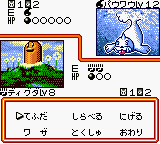
|

|
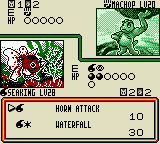
|
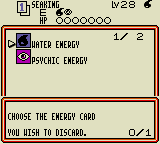
|
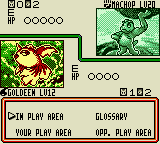
|
|---|---|---|---|---|---|
| Main duel screen (GB1) | Main duel screen (GB2) | Hand | Attack | Retreat | Check |

|
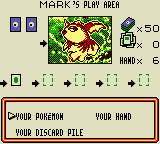
|
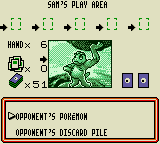
|

|

|
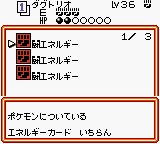
|
| Full play area | Player's play area | Opponent's play area | Party | Pokémon Powers | Energy cards attached to a Pokémon (GB2 only) |
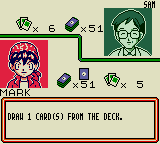
|
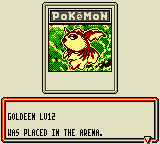
|
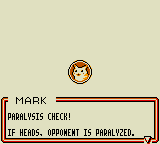
|

|
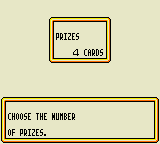
|
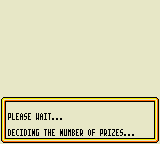
|
| Drawing a card | Placing a card in the Arena |
Tossing a coin | Starting a link duel | Choosing the number of prizes in a link duel |
Waiting while another player chooses the number of prizes |
Sprites
Types and stages (large sprites)
| Grass | Fire | Water | Lightning | Fighting | Psychic |
|---|---|---|---|---|---|
| Colorless | Trainer card | Energy card | Basic Pokémon |
Stage 1 Pokémon |
Stage 2 Pokémon |
Types (small sprites)
| Grass | Fire | Water | Lightning |
|---|---|---|---|
| Fighting | Psychic | Colorless | Rainbow (GB2 only) |
Stages (small sprites)
| Basic Pokémon |
Stage 1 Pokémon |
Stage 2 Pokémon |
|---|
Special Conditions
| Asleep | Confused | Paralyzed (JP) |
Paralyzed (INT) |
Poisoned |
|---|
Play area sprites
| GB1 | ||||
|---|---|---|---|---|
| Deck | Discard Pile | Prize card | Bench card | Bench space |
| GB2 | ||||
| Deck | Discard Pile | Prize card | Bench card | Bench space |
Other sprites
| HP (no damage) |
HP (damage) |
PlusPower | Defender | Food counter (GB2 only) |
Bench | Prize cards |
|---|
In other languages
| |||||||||||||||||||||
See also

|
This article is part of both Project Sidegames and Project TCG, Bulbapedia projects that, together, aim to write comprehensive articles on TCG-related video games. | 
|
